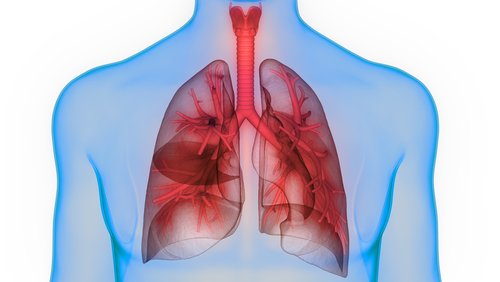Study Suggests TL1A Protein as Therapeutic Target for Lung Fibrosis
Written by |

A protein known as TL1A drives lung fibrosis, or scarring, in scleroderma, a new study suggests.
The findings suggest that blocking TL1A could be an effective therapeutic strategy in scleroderma and other conditions characterized by lung fibrosis, including severe asthma, and idiopathic pulmonary fibrosis.
Titled, “TL1A Promotes Lung Tissue Fibrosis and Airway Remodeling,” the study was published in The Journal of Immunology.
The lungs need to be elastic and stretchy in order to easily take in air. This is why lung fibrosis is a serious health problem, as scar tissue makes it more difficult for the lungs to expand during breaths.
At a cellular level, lung fibrosis is characterized by the overproduction of structural molecules such as collagen, which essentially form the scar tissue. Lung fibrosis also is characterized by the overgrowth of muscle cells around the lungs.
The exact biological processes that drive lung fibrosis in various diseases are still not fully understood, though increased inflammation is known to be involved. Better understanding these pathways could unveil new strategies for treatment.
In the new study, researchers at La Jolla Institute for Immunology, in California, examined the role of TL1A in lung fibrosis. TL1A is a signaling protein known to drive inflammation, including inflammation in the lungs. Previous research implicated TL1A in fibrosis in the colon. This protein acts on cells by binding to a receptor called DR3.
Injecting TL1A into the airways of mice resulted in increased collagen production and lung muscle growth. In other words, TL1A induced lung fibrosis.
“The effect on lung remodeling was generally quicker than has been reported for remodeling in other systems,” the researchers wrote, adding that this “was likely due to the high dose of the TL1A protein used and that its receptor was readily available on relevant cells to signal for these activities.”
DR3 is found on multiple types of cells, including T-cells and innate lymphoid cells (ILC), both of which are types of immune cells. Administering TL1A to mice lacking these two cell types still induced lung fibrosis. However, in animals engineered to lack DR3 entirely, TL1A did not induce scarring in the lungs.
“Thus, TL1A exerts profibrotic and remodeling activity in the lungs through DR3, independently of T cells and ILC,” the scientists wrote.
They next turned to a mouse model of lung fibrosis where scarring is induced with high doses of bleomycin, a medication used to treat certain cancers.
Upon bleomycin administration, mice lacking DR3 had less collagen accumulation and muscle cell overgrowth — less fibrosis — than healthy controls. Similar effects were achieved when an antibody was used to block TL1A signaling in controls.
Blocking TL1A signaling also reduced lung fibrosis in a mouse model of allergy-driven fibrosis.
“These results show that endogenous TL1A–DR3 signaling is central to the development of lung fibrosis and tissue remodeling downstream of two diverse stimulants,” the investigators wrote.
Further assessments revealed that DR3 is produced by many types of cells in the lungs. In particular, the protein is expressed on fibroblasts — the cells primarily responsible for producing collagen — in both mice and humans. Notably, high DR3 expression was found in fibroblasts taken from people with scleroderma and idiopathic pulmonary fibrosis.
Treating human fibroblasts in dishes with TL1A prompted these cells to divide more and produce more collagen and periostin, a protein marker of fibrosis.
Collectively, the results of this study show that TL1A signaling is involved in the development of lung fibrosis, suggesting that blocking the protein could be therapeutic.
“Our new study suggests that TL1A and its receptor on cells could be targets for therapeutics aimed at reducing fibrosis and tissue remodeling in patients with severe lung disease,” Michael Croft, PhD, the study’s senior author, said in a press release.
“This type of research needs to be expanded to really understand if there are subsets of patients with asthma or other inflammatory lung diseases who might express TL1A at higher levels than other patients — which could potentially guide future therapies for targeting TL1A to reduce remodeling and fibrosis,” Croft added.





